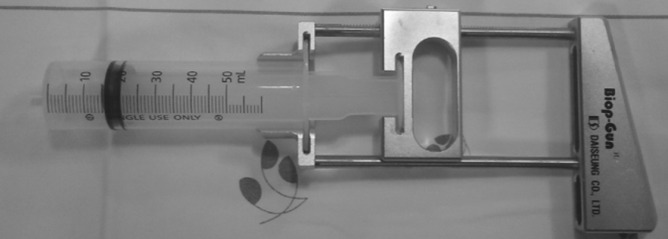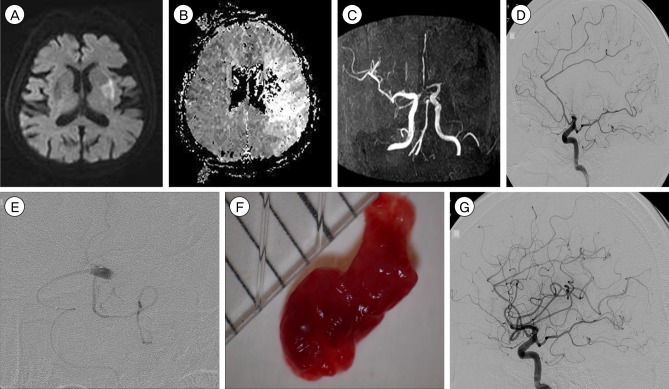J Cerebrovasc Endovasc Neurosurg.
2015 Mar;17(1):13-19. 10.7461/jcen.2015.17.1.13.
A Suction Thrombectomy Technique: A Rapid and Effective Method for Intra-Arterial Thrombolysis
- Affiliations
-
- 1Department of Neurosurgery, Gyeongsang National University Hospital, Gyeongsang National University School of Medicine, Jinju, Korea. 1coo3004@naver.com
- KMID: 1963144
- DOI: http://doi.org/10.7461/jcen.2015.17.1.13
Abstract
OBJECTIVE
During mechanical thrombolysis, to reduce procedure-related complications and time, the authors have performed a simple suction thrombectomy technique. In this article, the authors describe the technical details and clinical outcomes of this technique.
MATERIALS AND METHODS
From January 2013 to December 2013, 14 consecutive acute ischemic stroke (AIS) patients with large cerebral arterial occlusions in the middle cerebral artery (MCA; n = 7), internal cerebral artery (ICA; n = 5), basilar artery (BA; n = 1), and a tandem lesion (ICA and MCA; n = 1) were treated using this technique. The proximal part of the occluding clot was aspirated or captured and retrieved as one piece using a large bored microcatheter by applying negative suction pressure using a 50 mL syringe.
RESULTS
Overall recanalization rate was 85.7% (12 patients). In the 8 patients in whom this technique was used alone, the recanalization rate was 87.5% (7 patients). The median procedural duration was 30 minutes (range 17-112) in these 7 patients. Distal embolism did not occur. Two patients developed post-procedural intracerebral hemorrhages and one was symptomatic. His modified Rankin Scale (mRS) score at 90 days was 4.
CONCLUSION
This technique is a feasible, fast, and safe method for treatment of AIS.
Keyword
MeSH Terms
Figure
Cited by 2 articles
-
Dual Mechanical Thrombectomy for Recanalization of a Resistant Acute Posterior Circulation Stroke
Ahmet Peker, Ayça Akgoz, Ethem Murat Arsava, Mehmet Akif Topçuoglu, Anil Arat
J Cerebrovasc Endovasc Neurosurg. 2017;19(2):96-100. doi: 10.7461/jcen.2017.19.2.96.Real-Time Visualization of Thrombus during Suction Thrombectomy : Contrast-in-Stasis Technique
Yoon-Soo Lee
J Korean Neurosurg Soc. 2024;67(4):477-482. doi: 10.3340/jkns.2023.0158.
Reference
-
1. Penumbra Pivotal Stroke Trial Investigators. The penumbra pivotal stroke trial: safety and effectiveness of a new generation of mechanical devices for clot removal in intracranial large vessel occlusive disease. Stroke. 2009; 8. 40(8):2761–2768. PMID: 19590057.2. Tissue plasminogen activator for acute ischemic stroke. The National Institute of Neurological Disorders and Stroke rt-PA Stroke Study Group. N Engl J Med. 1995; 12. 333(24):1581–1587. PMID: 7477192.3. Abou-Chebl A. Endovascular treatment of acute ischemic stroke may be safely performed with no time window limit in appropriately selected patients. Stroke. 2010; 9. 41(9):1996–2000. PMID: 20651271.
Article4. Furlan A, Higashida R, Wechsler L, Gent M, Rowley H, Kase C, et al. Intra-arterial prourokinase for acute ischemic stroke. The PROACT II study: a randomized controlled trial. Prolyse in Acute Cerebral Thromboembolism. JAMA. 1999; 12. 282(21):2003–2011. PMID: 10591382.5. Grunwald IQ, Walter S, Papanagiotou P, Krick C, Hartmann K, Dautermann A, et al. Revascularization in acute ischaemic stroke using the penumbra system: the first single center experience. Eur J Neurol. 2009; 11. 16(11):1210–1216. PMID: 19659754.
Article6. Ikushima I, Ohta H, Hirai T, Yokogami K, Miyahara D, Maeda N, et al. Balloon catheter disruption of middle cerebral artery thrombus in conjunction with thrombolysis for the treatment of acute middle cerebral artery embolism. AJNR Am J Neuroradiol. 2007; 3. 28(3):513–517. PMID: 17353326.7. Jansen O, Schellinger P, Fiebach J, Hacke W, Sartor K. Early recanalisation in acute ischaemic stroke saves tissue at risk defined by MRI. Lancet. 1999; 6. 353(9169):2036–2037. PMID: 10376621.
Article8. Mpotsaris A, Bussmeyer M, Loehr C, Oelerich M, Buchner H, Weber W. Mechanical thrombectomy in severe acute stroke: preliminary results of the Solitaire stent. J Neurol Neurosurg Psychiatry. 2011; 1. 83(1):117–118. PMID: 21212105.9. Neumann-Haefelin T, Wittsack HJ, Wenserski F, Siebler M, Seitz RJ, Modder U, et al. Diffusion- and perfusion-weighted MRI. The DWI/PWI mismatch region in acute stroke. Stroke. 1999; 8. 30(8):1591–1597. PMID: 10436106.10. Nogueira RG, Schwamm LH, Buonanno FS, Koroshetz WJ, Yoo AJ, Rabinov JD, et al. Low-pressure balloon angioplasty with adjuvant pharmacological therapy in patients with acute ischemic stroke caused by intracranial arterial occlusions. Neuroradiology. 2008; 4. 50(4):331–340. PMID: 18172631.
Article11. Olivot JM, Albers GW. Diffusion-perfusion MRI for triaging transient ischemic attack and acute cerebrovascular syndromes. Curr Opin Neurol. 2011; 2. 24(1):44–49. PMID: 21157338.
Article12. Rha JH, Saver JL. The impact of recanalization on ischemic stroke outcome: a meta-analysis. Stroke. 2007; 3. 38(3):967–973. PMID: 17272772.13. Smith WS, Sung G, Saver J, Budzik R, Duckwiler G, Liebeskind DS, et al. Mechanical thrombectomy for acute ischemic stroke: final results of the Multi MERCI trial. Stroke. 2008; 4. 39(4):1205–1212. PMID: 18309168.14. Yoo DS, Won YD, Huh PW, Shin HE, Kim KT, Kang SG, et al. Therapeutic results of intra-arterial thrombolysis after full-dose intravenous tissue plasminogen activator administration. AJNR Am J Neuroradiol. 2010; 9. 31(8):1536–1540. PMID: 20395391.
- Full Text Links
- Actions
-
Cited
- CITED
-
- Close
- Share
- Similar articles
-
- Forced Arterial Suction Thrombectomy Using Distal Access Catheter in Acute Ischemic Stroke
- Real-Time Visualization of Thrombus during Suction Thrombectomy : Contrast-in-Stasis Technique
- Suction thrombectomy of distal medium vessel occlusion using microcatheter during mechanical thrombectomy for acute ischemic stroke: A case series
- Forced Arterial Suction Thrombectomy of Septic Embolic Middle Cerebral Artery Occlusion Due to Infective Endocarditis: an Illustrative Case and Review of the Literature
- Intra-Arterial Thrombolysis to Improve Final Thrombolysis in Cerebral Infarction Score after Thrombectomy: A Case-Series Analysis



